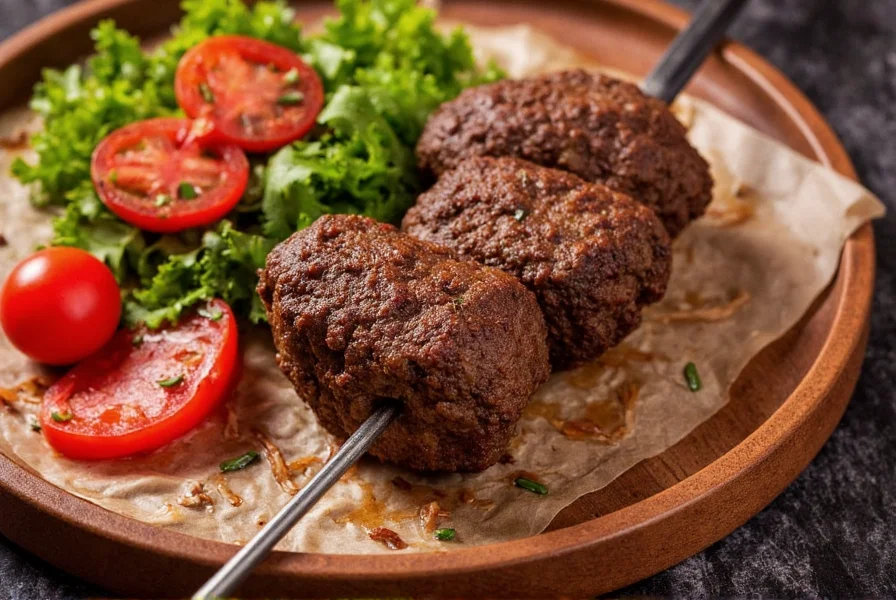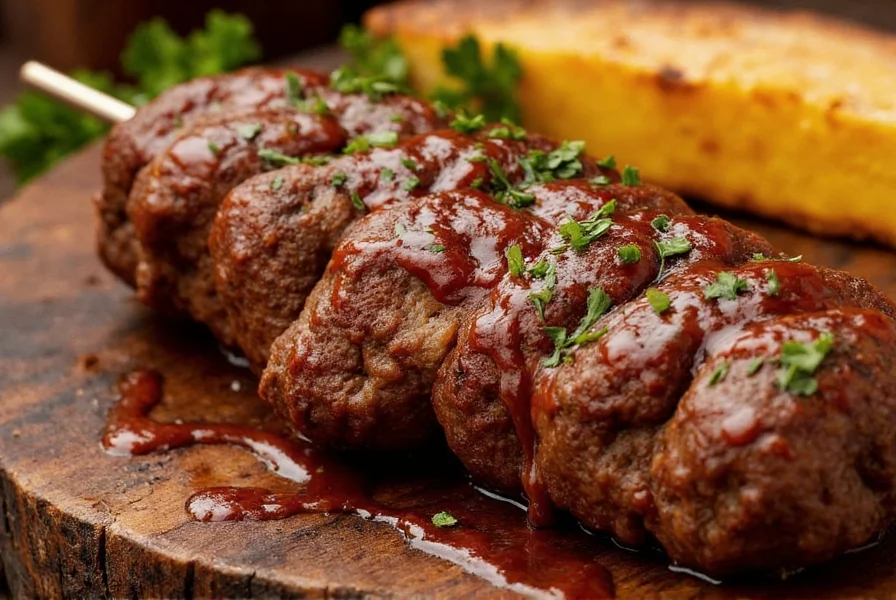Kofte kebab represents one of the most beloved culinary traditions across Turkey, the Middle East, and the Balkans. This iconic dish showcases the region's mastery of transforming simple ingredients into complex, flavorful meals through careful seasoning and preparation techniques passed down through generations.
The Cultural Roots of Kofte Kebab
The history of kofte kebab traces back to ancient Anatolia, where nomadic tribes developed methods to preserve and flavor ground meat. The word "kofte" derives from the Persian "kufta," meaning "to beat" or "to grind," reflecting the traditional preparation method of hand-chopping meat to achieve the perfect texture. As trade routes expanded, kofte traveled across regions, adapting to local ingredients and preferences while maintaining its essential character.
Unlike shish kebab which features cubed meat on skewers, kofte kebab's distinctive characteristic is its spiced ground meat composition. This preparation method allowed communities to utilize less expensive cuts of meat while creating dishes of remarkable depth and complexity. In Turkish culinary tradition, kofte represents more than just food—it's a symbol of hospitality and community, often served during family gatherings and celebrations.
Essential Ingredients for Authentic Kofte Kebab
The magic of exceptional kofte kebab lies in its ingredient balance. Traditional recipes call for:
- Meat selection: A combination of 70% lean meat (typically lamb or beef) with 30% fat content for optimal moisture and flavor
- Aromatics: Finely grated onions or shallots, which add moisture and subtle sweetness
- Binding agents: Soaked breadcrumbs or fine bulgur wheat to maintain shape during cooking
- Signature spices: Cumin, paprika, mint, and allspice in precise proportions
- Fresh herbs: Parsley and sometimes mint for brightness
Professional chefs emphasize that the meat should never be overmixed, as this develops the proteins too much and creates a dense, sausage-like texture rather than the desired light, tender consistency. The ideal kofte should hold its shape but remain delicate when cooked.
| Regional Variation | Key Characteristics | Distinctive Ingredients | Cooking Method |
|---|---|---|---|
| Turkish Adana Kofte | Long, flat cylinders on wide skewers | Extra spicy with pul biber (Turkish red pepper) | Charcoal grilled over high heat |
| Turkish Urfa Kofte | Smaller, oval-shaped patties | Milder spice profile with isot pepper | Grilled over medium heat |
| Lebanese Kibbeh | Deep-fried bulgur shell with meat filling | Finely ground bulgur outer layer | Fried or baked |
| Greek Keftedes | Small meatballs | Oregano and lemon zest | Pan-fried or grilled |
| Balkan Ćevapi | Small, finger-length cylinders | No breadcrumbs, pure minced meat | Grilled in groups |
Mastering the Cooking Technique
Proper cooking technique separates authentic kofte kebab from ordinary grilled meat. Traditional preparation involves shaping the mixture around flat metal skewers (rather than round ones) to maximize surface area for that essential char. The meat should be pressed firmly but not compacted, allowing for even cooking while maintaining tenderness.
For home cooks attempting traditional Turkish kofte kebab recipe success, temperature control proves crucial. Start with a very hot grill to sear the exterior, then reduce heat to cook through without burning. Most experts recommend cooking kofte over charcoal rather than gas for authentic flavor, as the smoke enhances the natural meat flavors. The ideal internal temperature reaches 160°F (71°C) for food safety while preserving juiciness.
One professional tip often overlooked: let the shaped kofte rest in the refrigerator for at least 30 minutes before cooking. This allows the flavors to meld and helps maintain shape during grilling. When turning kofte on the grill, use tongs rather than piercing with a fork to prevent precious juices from escaping.

Serving Traditions and Accompaniments
In Turkey and surrounding regions, kofte kebab never appears alone. Traditional serving includes:
- Pide or lavash: Freshly baked flatbread for wrapping
- Sumac onions: Thinly sliced red onions tossed with sumac and parsley
- Tomato salad: Chopped tomatoes, cucumbers, and green peppers with olive oil
- Yogurt sauce: Thick yogurt with garlic, cucumber, and mint
- Rice pilaf: Often cooked with butter and vermicelli
The complete dining experience involves wrapping small portions of kofte with accompaniments in warm bread—a technique that combines textures and flavors in each bite. Many restaurants serve kofte with a side of grilled tomatoes and peppers that have absorbed the meat's drippings during cooking, adding another dimension to the meal.
Common Preparation Mistakes to Avoid
Even experienced home cooks make critical errors when attempting authentic kofte kebab. The most frequent issues include:
- Overmixing the meat: Creates a dense, tough texture rather than tender kofte
- Using overly lean meat: Results in dry, crumbly kebabs without sufficient fat content
- Skipping the resting period: Prevents flavors from melding and causes shape loss during cooking
- Incorrect spice ratios: Overpowering individual spices rather than balanced flavor profile
- High-heat cooking throughout: Burns exterior before interior cooks properly
For those seeking the best meat for kofte kebab, many Turkish chefs recommend a blend of 60% lamb shoulder and 40% beef chuck. The lamb provides distinctive flavor while the beef offers structure. When properly prepared, authentic kofte kebab should have a slightly crisp exterior with a moist, flavorful interior that falls apart delicately when eaten.
Identifying Quality Kofte Kebab
When dining out, certain visual and aromatic cues indicate authentic, high-quality kofte kebab. Look for:
- Color variation: A mix of charred spots and pinkish interior (not gray throughout)
- Texture: Visible small irregularities rather than perfectly smooth, processed appearance
- Aroma: Distinctive smoky scent with herbal notes, not just generic grilled meat smell
- Juiciness: Visible moisture when cut, not dry or crumbly
- Shape retention: Holds form without being overly compacted
Understanding these characteristics helps identify establishments that prepare traditional kofte kebab rather than mass-produced versions. The most authentic restaurants often prepare kofte to order rather than pre-shaping large batches, ensuring optimal freshness and texture.
Frequently Asked Questions
What's the difference between kofte and other kebabs?
Kofte kebab specifically refers to kebabs made from seasoned ground meat formed into shapes, while other kebabs like shish kebab use cubed meat. The preparation method, spice blend, and texture distinguish kofte from other kebab varieties. Traditional kofte contains a specific blend of spices including cumin and paprika, and is shaped around flat skewers rather than round ones.
Can kofte kebab be made with chicken or vegetarian alternatives?
Yes, while traditional kofte uses lamb or beef, modern variations include chicken kofte and vegetarian options using mushrooms, lentils, or chickpeas. Chicken kofte typically requires additional moisture sources like yogurt, while vegetarian versions often incorporate bulgur or breadcrumbs for texture. These alternatives maintain the characteristic spice profile while adapting to different dietary preferences.
How do I prevent my homemade kofte from falling apart on the grill?
To prevent kofte from falling apart, ensure proper binding with soaked breadcrumbs or fine bulgur, maintain the correct meat-to-fat ratio (70% lean to 30% fat), avoid overmixing, and refrigerate shaped kofte for at least 30 minutes before cooking. Using flat metal skewers rather than round ones also helps maintain shape during grilling, as does proper temperature control—starting hot for searing then reducing heat.
What are the essential spices in authentic Turkish kofte kebab?
Authentic Turkish kofte kebab typically includes cumin, paprika (both sweet and sometimes spicy varieties), dried mint, and allspice. Some regional variations add sumac, cinnamon, or isot pepper (Urfa pepper). The precise balance of these spices creates the distinctive flavor profile, with cumin providing earthiness, paprika adding color and mild heat, and mint contributing freshness that cuts through the richness of the meat.
How long should kofte kebab be grilled for perfect results?
Traditional kofte kebab requires approximately 10-12 minutes of grilling time, with initial high heat for 2-3 minutes per side to create a crust, followed by medium heat to cook through. The exact time depends on thickness, but the internal temperature should reach 160°F (71°C). Turning only once or twice prevents juice loss. Properly cooked kofte should have a slightly charred exterior with a moist, pinkish interior that's fully cooked but not dry.











 浙公网安备
33010002000092号
浙公网安备
33010002000092号 浙B2-20120091-4
浙B2-20120091-4